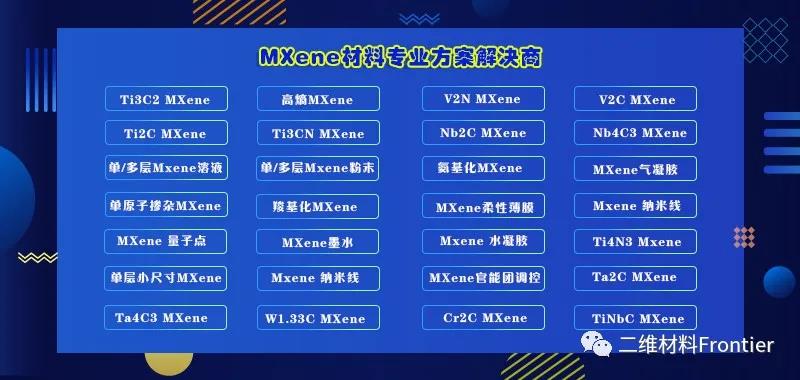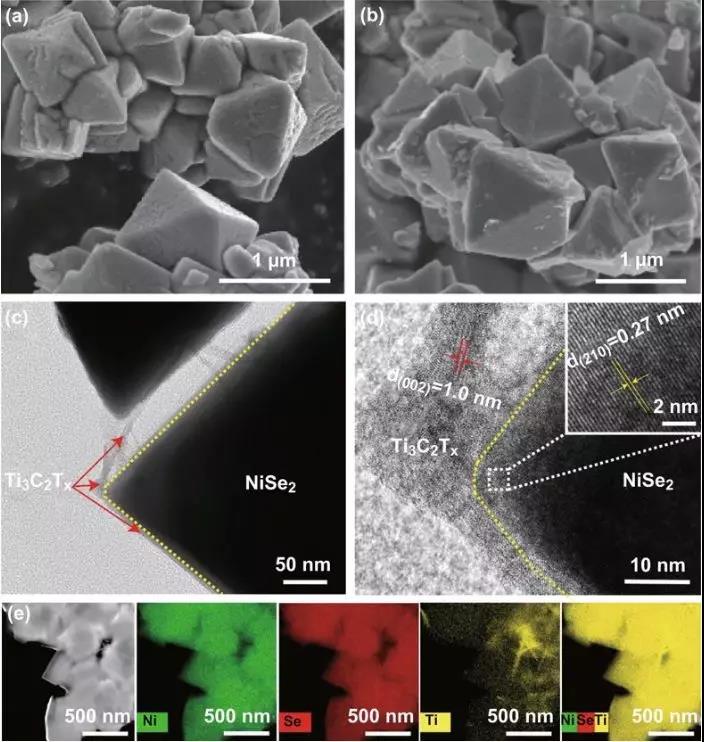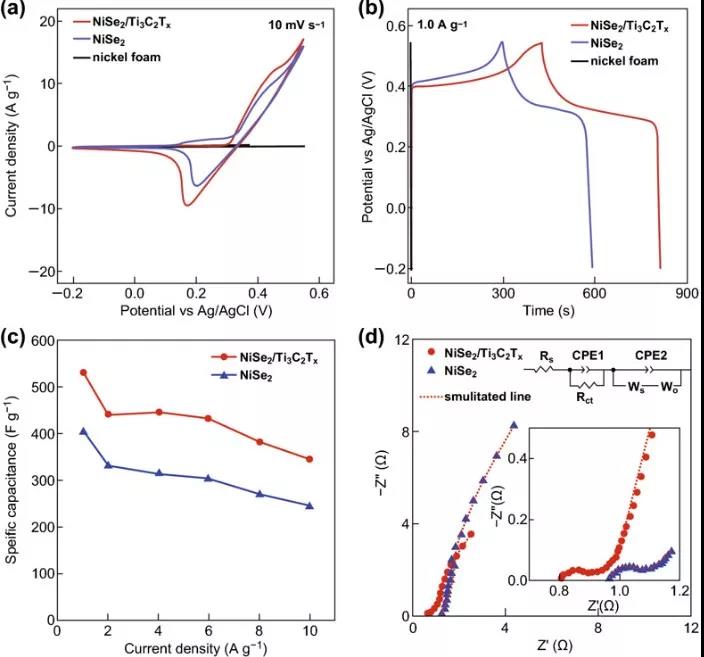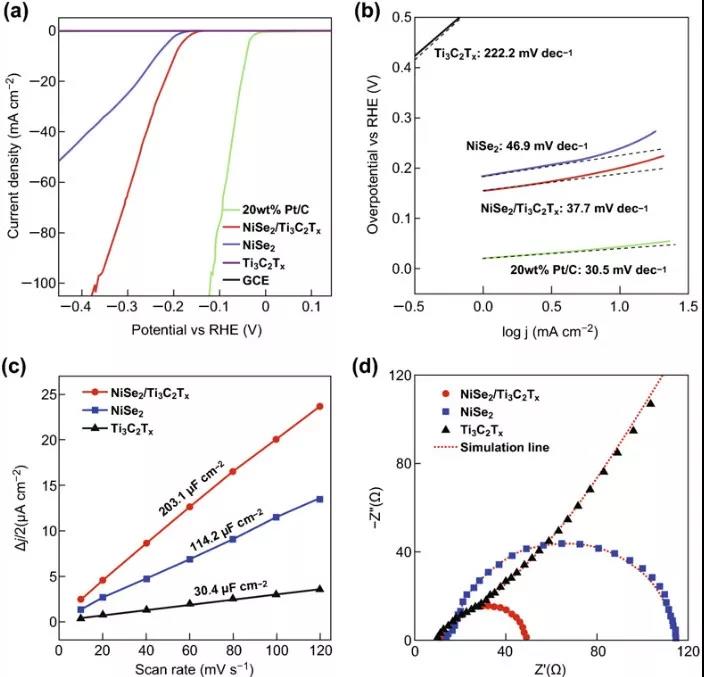NML Research Article£üInterface function "shows its talents": NiSe2/Ti3C2Tx(MXene) helps super-electricity and electrocatalytic water splitting!

Highlights of this article
1 Using ultra-thin MXene nanosheets to wrap NiSe2 octahedral crystals, a strong interface chemical interaction between NiSe2 nanocrystals and MXene nanosheets (NiSe2/Ti3C2Tx) was established.
2 The NiSe2/Ti3C2Tx composite exhibits excellent performance and cycle stability in both supercapacitors and hydrogen evolution reactions.
3 NiSe2 nanocrystals are stabilized by the MXene nanoflake as its oxidation protective layer.
brief introductionSelenide metal compounds, such as NiSe2, have shown great potential as a multifunctional energy storage and communication material. However, pure NiSe2 has poor cycle stability, low conductivity, and insufficient electrochemical active sites, which limits its application as an electrode material.
👇
In order to make up for these defects, the research group of Professor Dong Lichun of Chongqing University used ultra-thin MXene nanosheets to wrap NiSe2 octahedral crystals to prepare a new NiSe2/Ti3C2Tx composite with strong interfacial interaction and excellent electrical properties.
The NiSe2/Ti3C2Tx mixture shows good electrochemical performance. When the current density is 1 A/g, the specific capacitance of the supercapacitor is as high as 531.2 F/g. At the same time, when used in the hydrogen evolution reaction, the Tafel slope is only 37.7 mV. /dec.
In addition, the cycle stability of NiSe2/Ti3C2Tx composites in supercapacitors and HER has been improved.
Compared to NiSe2, these significant improvements should be attributed toThe strong interface interaction between NiSe2 octahedral crystal and Ti3C2Tx provides enhanced conductivity, fast charge transfer and abundant active active sites.At the same time, this combination of multi-functional applications has potential, such as energy storage and conversion.
Graphic guide
NiSe2ºÍNiSe2/Ti3C2TxAnalysis of the microscopic morphology and structure of composite materials
As shown in Figure 1, the unmodified NiSe2 and NiSe2/Ti3C2Tx composites all show a typical octahedral configuration under a scanning electron microscope, with an average size of about 1 ¦Ìm.
However, there seems to be relatively more glass on the surface of NiSe2/Ti3C2Tx crystals. TEM further analysis shows that this phenomenon may be due to
The surface of the octahedral NiSe2 particles is uniformly covered with an ultra-thin layer of Ti3C2Tx nanosheets (Figure 1c), which may provide additional electrical transport paths for charge storage or electrocatalysis.

Figure 1 SEM images of NiSe2 without (a) and (b) Ti3C2Tx composites. (c, d) TEM images of NiSe2/Ti3C2Tx composites at different magnifications. (e) The NiSe2/Ti3C2Tx mixture of the HAADF−STEM image and the Ni, Se, and Ti elements mapped by the corresponding EDX elements.
👇
NiSe2ºÍNiSe2/Ti3C2TxAnalysis of electrochemical performance of composite materials
NiSe2ºÍNiSe2/Ti3C2TxAnalysis of superelectric properties of composite materials
It can be seen from Figure 3 that compared with unmodified NiSe2, the capacity of NiSe2/Ti3C2Tx composite material has been greatly improved. In addition, due to the surface modification of MXene, the conductivity of the material has also been greatly improved, and the contact resistance There has also been a decline.

Figure 3 The performance of supercapacitors in 2 M KOH solution: (a) CV graphs of unmodified NiSe2 and NiSe2/Ti3C2Tx at a sweep rate of 10 mV/s. (b) GCD curves of unmodified NiSe2 and NiSe2/Ti3C2Tx at a current density of 1.0 A/g. (c) Current density specific volume graphs of unmodified NiSe2 and NiSe2/Ti3C2Tx. (d) Nyquist diagram of unmodified NiSe2 and NiSe2/Ti3C2Tx (the inset shows the high-frequency region and the equivalent circuit of the fitted experimental data)
👇
Analysis of HER performance of NiSe2 and NiSe2/Ti3C2Tx composites
As shown in Figure 4, the composite product has better catalytic activity. The improvement of NiSe2/Ti3C2Tx electrode performance is due to the charge transfer from NiSe2 to Ti3C2Tx, which may provide faster adsorption kinetics and higher active site utilization, thereby improving HER efficiency

Figure 4 Catalytic performance in 0.5 M H2SO4 solution: (a) LSV of unmodified NiSe2, NiSe2/Ti3C2Tx composite, pure Ti3C2Tx, 20 wt% Pt/C at a scan rate of 5 mV/s glassy carbon electrode curve. (b) Tafel plot of unmodified NiSe2, NiSe2/Ti3C2Tx composite, pure Ti3C2Tx, and 20 wt% Pt/C. (c) Use cyclic voltammetry to extract the double-layer capacitance of different electrodes. (d) Impedance diagrams of different electrode materials.
18915694570
Previous£º Lin Jun/Hou Zhiyao/Li


